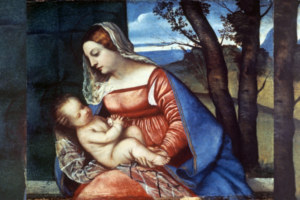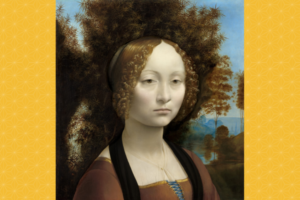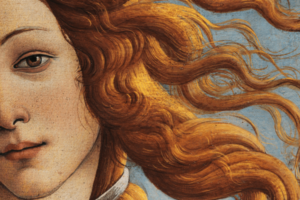The Italian Renaissance, a glorious period spanning from the 14th to the 17th century, was a time of profound cultural, artistic, and scientific rebirth. It marked the bridge between the Middle Ages and the Modern era, thrusting Europe from the dim corridors of the Gothic period into a luminescent world where humanity took center stage. Cities like Florence, Venice, and Rome became epicenters of innovation, each echoing with the brushstrokes of genius.
In this era, art was not just an aesthetic pleasure; it was an exploration of human potential, emotion, and perspective. Central to this exploration was the masterful manipulation of light and shadow in painting. Just as the philosophers of the time sought illumination in thought, artists pursued it on canvas. The way a painter could turn a flat surface into a three-dimensional space, full of emotion and depth, largely depended on their treatment of light and its interplay with shadow.
Enter “chiaroscuro”, an artistic technique born from this very pursuit. Derived from the Italian words for ‘light’ (“chiaro”) and ‘dark’ (“scuro”), chiaroscuro became more than just a method; it was a revolution. By contrasting stark lights with deep shadows, artists could imbue their subjects with a lifelike volume, depth, and emotion never seen before. This technique became a defining feature of the Renaissance, symbolizing the era’s broader quest for understanding, clarity, and enlightenment.
In this article, we journey through the luminous world of Italian Renaissance painting, discovering how the dance of light and shadow on canvas echoed the greater symphony of change and reawakening in Europe.
Historical Background
The very fabric of Europe was undergoing a metamorphosis as the Middle Ages waned. The seeds of change, watered by human curiosity and a renewed interest in classical antiquity, took root most vibrantly in the Italian Peninsula. This epoch, which we now recognize as the Italian Renaissance, wasn’t just a period but a movement—a cultural tidal wave that reshaped art, science, politics, and thought.
Cities as Crucibles of Change
Several Italian cities emerged as powerhouses of this Renaissance movement. Florence, under the watchful eyes of the Medici family, became an unparalleled center of art and scholarship. Here, the free flow of ideas combined with an environment that championed creative expression. Venice, with its vast maritime empire, became a melting pot of cultures and artistic styles, its art infused with the light and color of its watery landscape. Rome, spurred by the papacy’s ambitions, resurrected its ancient grandeur and beckoned artists from across the continent to redefine its sacred spaces.
The Patrons: Catalysts of Creativity
The art of this period didn’t thrive in a vacuum. It was bolstered by patrons, individuals or families who financed and championed the arts. The aforementioned Medici in Florence, the Borgia in Rome, and the Doges in Venice were but a few of the prominent patrons. They not only provided resources but also often dictated themes, pushing artists to surpass their boundaries, leading to innovative techniques and approaches.
Cultural Shifts and their Artistic Echoes
The Italian Renaissance was characterized by a turn away from the predominantly religious themes of the medieval era and a rekindling of interest in classical Greek and Roman philosophies, mythology, and aesthetics. This shift was evident in the art, where religious figures started being portrayed with human emotions, and pagan subjects found prominence on canvases.
From Flat Figures to Dynamic Depth
Before the Renaissance, European art, especially during the Gothic period, was dominated by flat, two-dimensional figures with a lack of depth or perspective. Backgrounds were often gold leaf, and figures were stylized rather than realistic. However, as the Renaissance progressed, there was a seismic shift in these techniques. The introduction of linear perspective by artists like Brunelleschi and its adoption by others like Masaccio transformed the flat landscapes into deep, receding spaces. The figures became more lifelike, their proportions corrected, and their positions in space clearly defined.
This transformation wasn’t just about accuracy; it was an attempt to bring a slice of the real world into the canvas, to make art a mirror to life. And central to this mirroring was the masterful application of light and shadow, a technique that would go on to define the very essence of Renaissance art.
As we delve deeper into the world of Italian Renaissance painting, we will see how the innovations of this era, driven by cities, patrons, and cultural shifts, set the stage for an art form that marveled in its mastery of light and shadow.
Chiaroscuro: Definition and Origins
The pages of art history are imbued with terms and techniques that define eras and movements, but few are as evocative or transformative as “chiaroscuro.” Its very essence lies in its name, an amalgamation of the Italian words for ‘light’ and ‘dark’. But what exactly is chiaroscuro, and how did it originate?
What is Chiaroscuro?
Chiaroscuro, at its core, is an artistic technique that employs strong contrasts between light and dark to achieve a sense of volume and depth in two-dimensional works of art. By manipulating shadows and highlights, artists could create the illusion of three-dimensionality on a flat canvas, bestowing their subjects with tangible weight, form, and texture.
More than just a method, chiaroscuro also became a mood. The juxtaposition of light and dark could evoke a range of emotions, from the serene to the dramatic, allowing artists to influence the viewer’s perception and emotional response to a piece.
Historical Precursors
While the Renaissance may have given chiaroscuro its name and fame, the origins of playing with light and shadow can be traced further back. Ancient civilizations, like the Greeks and Romans, showed awareness of how light can define form, particularly in their sculptures. However, the consistent and conscious use of this concept in painting required a confluence of factors—cultural, philosophical, and technical—that found its zenith in the Renaissance.
During the Middle Ages, European art displayed a limited understanding of depth and volume. Paintings from this era, though beautiful and symbolic, often portrayed figures in a flat, two-dimensional manner. There was minimal shading, and backgrounds, especially in religious art, were dominated by gold leaf, which didn’t allow for the play of light and shadow.
Evolution of the Technique
It was in the budding atmosphere of the Renaissance that artists began to re-explore the classical past, discovering (or perhaps, re-discovering) the principles of light’s interaction with form. The reintroduction of naturalism into art, combined with advances in understanding perspective and anatomy, set the stage for chiaroscuro’s evolution.
Artists began to experiment with gradients of light and shadow, initially subtly, and then with increasing boldness. Leonardo da Vinci was a pioneer in this area, with his “sfumato” technique—a way of blending tones seamlessly, without any clear transitions, creating a smoky or hazy effect. This soft gradation between light and dark added depth and volume to his subjects, making them seem to emerge from or recede into the canvas.
As the Renaissance progressed, chiaroscuro was adopted and adapted by various artists, each adding their own flair to the technique. Caravaggio took it to an extreme with his intense contrasts, creating dramatic scenes that seemed to be illuminated by a stark, divine light.
The birth and evolution of chiaroscuro wasn’t just a testament to artistic innovation; it was reflective of the Renaissance spirit—a spirit that sought depth, dimension, and a nuanced understanding of the world, both seen and unseen.
Technical Aspects of Chiaroscuro
The ethereal allure of chiaroscuro isn’t merely a product of its visual impact; it’s deeply rooted in its technical intricacies. By harnessing the dynamics of light and shadow, artists could craft scenes with an almost tangible depth, revolutionizing not only the art form but also the viewer’s experience.
Contrasting Light and Dark for Three-Dimensionality
At its most fundamental, chiaroscuro relies on the strategic placement of light and dark areas on a canvas. These contrasts act as visual cues, telling the viewer about the form, structure, and depth of the objects or figures depicted.
Highlight: This is the brightest part of the artwork, where the light source directly hits the subject. It provides the viewer with information about the light’s direction and intensity.
Mid-tones: These are the intermediate values, representing the gradual transition between the light and shadowed areas. Proper rendering of mid-tones is essential for creating a smooth, realistic representation of volume.
Core Shadow: This is the darkest part of the shadow on the subject, where light is completely blocked.
Reflected Light: Often overlooked but crucial for realism, this is the light that bounces off nearby surfaces and softly illuminates parts of the subject that aren’t directly hit by the main light source. It prevents the shadowed areas from looking flat.
Cast Shadow: This is the shadow that the subject casts on other surfaces, providing clues about the subject’s form and the spatial relationships in the scene.
By manipulating these elements, artists could create an illusion of depth and volume on a two-dimensional canvas, guiding the viewer’s eye through the artwork and establishing focal points.
Transforming Perception of Space, Volume, and Emotion
The Renaissance marked a departure from the flat, symbolic representations of the Middle Ages. With the advent of chiaroscuro, art wasn’t just a depiction; it became an environment, a space with depth and atmosphere that one could almost step into.
Spatial Depth: By using graduated shades, artists could push parts of their composition into the background and bring others to the forefront, creating a sense of distance and spatial hierarchy.
Volume and Texture: No longer were subjects mere outlines filled with color. The careful application of light and shadow gave them form and weight. Furthermore, by varying the sharpness and softness of the transitions between light and shadow, artists could hint at the texture of surfaces, differentiating between the smoothness of silk and the roughness of tree bark, for example.
Emotional Depth: Beyond the physical, chiaroscuro also added emotional depth to artworks. The interplay of light and shadow could set the mood of a scene, from the serene glow of a peaceful afternoon to the tense, dramatic atmosphere of a stormy night. By controlling where light fell and where shadows lurked, artists could emphasize certain emotions, guide narrative focus, and invoke specific reactions from the viewer.
Chiaroscuro’s power wasn’t just in its ability to mimic the real world; it was in its potential to elevate reality, to sculpt light and shadow in ways that captured both the tangible and the intangible. Through this technique, Renaissance artists not only showcased their understanding of the world around them but also their insights into the human soul, making their works resonate on multiple levels.
Key Artists and Their Contributions
The Renaissance wasn’t just a period; it was a grand ensemble of genius minds that collectively pushed the boundaries of art, science, and philosophy. At the heart of this artistic revolution was chiaroscuro, a technique that many adopted but a select few truly mastered. Let’s delve into the luminous world of some of these maestros and their masterpieces.
Leonardo da Vinci
Introduction to Leonardo’s Work and Influence
Often hailed as the quintessential “Renaissance Man,” Leonardo da Vinci wasn’t just an artist; he was an innovator. His incessant curiosity about the natural world, combined with his astute observational skills, informed his artistry. He delved deep into the science of light, examining how it interacts with surfaces and how the human eye perceives it.
Exemplary Paintings
“The Last Supper”: One of Leonardo’s most iconic works, this mural showcases his genius in using light to create emphasis and emotion. The illumination around Christ, the central figure, draws the viewer’s attention while the shadows surrounding the apostles enhance the mood of suspense and uncertainty.
“Mona Lisa”: In this enigmatic portrait, Leonardo’s use of “sfumato”—a technique of soft shading without stark transitions—creates a delicate interplay of light and shadow on Mona Lisa’s face, giving her an almost ethereal, three-dimensional quality.
Caravaggio
Revolutionary Approach
Caravaggio is often credited with taking chiaroscuro to its extreme, employing what’s known as “tenebrism”—a dramatic, high-contrast style where darkness becomes a dominant feature. His works often appear as though illuminated by a single, intense light source, casting sharp shadows and creating heightened drama.
Key Works
“The Calling of Saint Matthew”: This painting exemplifies Caravaggio’s dramatic use of light. A divine beam illuminates Matthew, singling him out among the other figures, capturing the exact moment of his divine calling.
“Judith Beheading Holofernes”: In this intense scene, Caravaggio’s stark lighting accentuates the brutality of the act, making the viewer almost flinch from the visceral emotions portrayed.
Michelangelo
Though primarily known as a sculptor, Michelangelo’s frescoes are a testament to his mastery over chiaroscuro. His ability to “sculpt” with paint, using light and shadow, gave his figures an arresting depth and dynamism.
Sistine Chapel: In this magnum opus, the frescoes depict a series of Biblical scenes, with figures that seem to protrude from the ceiling, a result of Michelangelo’s adept use of chiaroscuro, making them seem sculpted rather than painted.
Raphael
Raphael’s approach to chiaroscuro was subtler than his contemporaries, using it to impart a harmonious, soft quality to his figures.
“The School of Athens”: In this celebration of philosophy and knowledge, Raphael’s gentle gradients of light and shadow lend depth to the architecture and volume to the myriad of figures, while also directing the viewer’s gaze to the central figures of Plato and Aristotle.
Other Notable Artists
Titian: As one of the leaders of the Venetian School, Titian’s works, such as “Venus of Urbino,” employed a rich color palette with a masterful treatment of light to give his subjects a radiant, soft glow.
Tintoretto: Known for his speed and dynamism, Tintoretto’s “The Last Supper” offers a unique, diagonal play of light, creating a dynamic, almost theatrical scene.
The legacy of these artists is not just in the beauty they created but in the techniques they developed, refined, and passed down through generations. Their masterful use of chiaroscuro shaped the visual language of the Renaissance and continues to influence artists to this day.
The Influence of Chiaroscuro on Viewer Emotion
Throughout art history, artists have leveraged the power of light and shadow not only to shape form but also to stir souls. Chiaroscuro, with its dramatic interplay of luminance and obscurity, possesses the unique ability to guide viewer emotions, creating atmospheres that evoke everything from serene contemplation to deep, unsettling tension. But how exactly does this technique accomplish this? And what deeper implications does it carry?
Manipulating Mood, Focus, and Interpretation
Guided Attention: Light naturally draws the human eye. By selectively illuminating specific parts of a composition, artists can control where viewers first direct their gaze and where they linger. This focused attention gives prominence to certain elements, making them pivotal to the narrative of the piece.
Depth of Emotion: Deep shadows can evoke feelings of mystery, uncertainty, or sorrow, while brightly lit scenes might convey hope, joy, or divine intervention. The degree of contrast itself can amplify emotional intensity—a scene with stark, jarring differences between light and dark can feel more dramatic or tumultuous.
Ambiguity and Interpretation: The interplay between light and shadow can also introduce elements of ambiguity. Partially shadowed faces or figures can be both revealing and concealing, allowing viewers to project their interpretations or feelings onto the artwork.
Religious and Philosophical Implications
The Renaissance was a period of immense cultural and intellectual upheaval, marked by a renewed interest in individualism and the human experience. Chiaroscuro, in this context, was more than just a technique—it was symbolic.
Divinity and Mortality: Many Renaissance works, especially those of a religious nature, utilized chiaroscuro to differentiate the divine from the mortal. Light often symbolized divine presence or favor, while shadows could represent doubt, sin, or mortality.
The Human Soul: The nuanced play of light and shadow also symbolized the complexities of the human soul, with its capacities for both enlightenment and ignorance, virtue and vice.
Individualism and Introspection: As society began to emphasize the value and experiences of the individual, chiaroscuro became a tool to highlight personal introspections, dilemmas, and emotions. Portraits, in particular, evolved from mere representations to deeper psychological explorations.
Legacy and Influence on Later Art Movements
The influence of chiaroscuro extended far beyond the Renaissance, laying the foundation for several art movements:
Baroque: Carrying forward the dramatic intensity of chiaroscuro, the Baroque period saw artists like Rembrandt and Vermeer further pushing the boundaries of light and shadow, creating works that were deeply emotive and theatrical.
Romanticism: Artists of the Romantic era, such as Francisco Goya, used chiaroscuro to evoke the tumultuous emotions associated with nature, human passion, and the supernatural.
Film Noir and Cinema: The legacy of chiaroscuro can also be seen in film, especially in the Film Noir genre of the mid-20th century, where high-contrast lighting created moods of suspense, mystery, and existential angst.
Contemporary Art: Modern artists, even as they experiment with new mediums and forms, still turn to the age-old technique of chiaroscuro to lend depth, drama, and emotion to their works.
In essence, chiaroscuro is a testament to art’s profound ability to mirror—and shape—human emotion and thought. Its legacy reminds us of the timeless interplay between light and dark, both on canvas and within the depths of the human soul.
Legacy and Influence on Later Art Movements
Chiaroscuro, birthed in the luminous studios of Renaissance maestros, not only shaped its own era but left an indelible mark on the artistic movements that followed. Its influence can be seen in the way artists in subsequent periods approached light, form, and emotion, evolving and adapting the technique to their distinct styles and visions.
The Baroque Period: Dramatic Illumination Intensified
Following the Renaissance, the Baroque period took the torch of chiaroscuro and ran with it, pushing the contrasts to even greater extremes to evoke deep emotion and theatricality.
Caravaggio: While a figure from the late Renaissance, Caravaggio’s bold use of tenebrism—a style marked by dramatic illumination and stark shadows—set the stage for many Baroque artists. His religious scenes, alive with visceral emotion and tension, showcased the power of light as both a physical and spiritual element.
Rembrandt: This Dutch master took chiaroscuro and infused it with a deeply personal touch. His self-portraits and biblical scenes are rendered with soft yet profound contrasts, where light seems to emanate from within the subjects, illuminating their innermost thoughts and emotions.
Impressionism: A Different Dance with Light
The Impressionists, while moving away from the meticulous realism and drama of chiaroscuro, still owed much to the technique, albeit in a modified form.
Break from Realism: Impressionists like Monet, Renoir, and Degas were more interested in capturing fleeting moments and the play of light in them. Rather than the sharp contrasts of chiaroscuro, they utilized dappled light and color variations to depict their scenes.
Plein Air Painting: Painting outdoors, or “en plein air,” became popular among Impressionists. This allowed them to study natural light and its ever-changing effects on the environment, leading to works that, while not characterized by dramatic shadows, still showcased a deep understanding of light’s nuances.
Modern-Day Adaptations and Interpretations
In contemporary art, the legacy of chiaroscuro manifests in diverse ways, from adaptations in new mediums to conceptual evolutions.
Film and Cinematography: As mentioned previously, the Film Noir genre of the mid-20th century is a direct descendent of chiaroscuro, with its high-contrast, moody lighting. Directors like Christopher Nolan and Guillermo del Toro often employ chiaroscuro techniques to create atmospheric, emotionally charged scenes.
Digital Art and Photography: Digital artists and photographers, armed with tools that allow for precise control over lighting, often draw inspiration from chiaroscuro, crafting images with a depth and drama that harken back to Renaissance canvases.
Conceptual Evolution: Modern art, with its myriad styles and philosophies, has seen artists take the concept of light and shadow and expand it beyond the literal. Abstract artists may employ contrasts not just of color but of texture, shape, and concept, echoing the foundational principles of chiaroscuro in new and innovative ways.
In tracing the path of chiaroscuro through the annals of art history, we witness the enduring allure of light and shadow. This technique, rooted in the Italian Renaissance, has traversed epochs, adapting and evolving but never losing its power to captivate, challenge, and inspire.
Conclusion
As we journey through the tapestry of art history, certain threads shimmer with more vibrancy than others. One such thread, undeniably, is the masterful use of light and shadow that characterized the Italian Renaissance painting. Chiaroscuro, more than just a technique, became the lifeblood of a generation of artists, infusing their works with depth, emotion, and an uncanny realism that transcends time.
The Italian Renaissance, often extolled as a golden age of art and intellect, did not merely introduce new themes or subjects; it revolutionized how artists perceived and portrayed the world around them. Through the deft manipulation of light and shadow, the two-dimensional canvas was transformed into a window, capturing moments of profound emotion, introspection, and narrative drama. These scenes, whether of divine epiphanies or everyday life, were made palpable, pulling viewers into their depths, making them participants rather than mere observers.
Yet, the true power of chiaroscuro—and indeed any artistic technique—lies not in its visual impact alone. It serves as a testament to the transformative power of technique in art. With the right tools and mastery, artists can reshape how we perceive the world, leading us to see, feel, and think differently. Techniques evolve, and styles shift, but the enduring legacy of the Italian Renaissance reminds us of the infinite possibilities that lie at the intersection of skill, vision, and innovation.
As we step back and appreciate the luminous legacy of the Italian Renaissance, we are reminded that art, in its purest form, is alchemy. With pigment, canvas, and light, artists of this era transmuted base materials into gold, leaving a legacy that continues to illuminate the corridors of history, casting shadows that beckon us to look, reflect, and be transformed.



